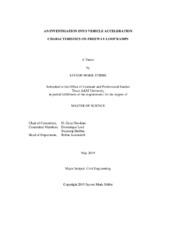| dc.description.abstract | Freeway loop ramps are the most restrictive common interchange ramp design, with sharp curves and low design speeds. Drivers utilizing these ramps can be forced to accelerate rapidly on entry ramps or decelerate rapidly on exit ramps. This thesis has several goals: to gain information about acceleration and deceleration on freeway loop ramps—both where it occurs and the magnitude of the speed change rate; to evaluate what ramp characteristics are most predictive of speed change rate and form models based off of these characteristics; to use the observed speed change rates to form a way to test for the adequacy of auxiliary lanes.
To accomplish these goals, the author uses a large dataset from the Strategic Highway Research Program 2 Naturalistic Driving Study (SHRP2 NDS). The dataset contains time-series vehicle dynamic data from nearly 2,000 vehicle trips on 20 freeway loop ramps in 5 states. The author supplemented this data set to be able to tie the dataset to physical locations and analyze the impact of various ramp characteristics on the speed change rates. The author uses two new terms, deceleration ratio and acceleration ratio to show where on the loop ramps deceleration and acceleration occur. Next, the actual deceleration rates and acceleration rates are shown and compared to the commonly used current rates. The author then models these rates using the most predictive ramp variables—radius of curve and speed limit of the adjacent freeway. Next, the author calls for updating the assumption of vehicle acceleration on ramps, suggesting that the rates of acceleration and deceleration may be closer than previously assumed and that acceleration may not be constant on loop ramps. Finally, the author introduces a method for determining the adequacy of auxiliary lanes on freeway loop ramps.
In this thesis, the author finds that much of the acceleration on entrance loop ramps and deceleration on exit loop ramps occurs outside of the loop ramp proper—on either the freeway or the auxiliary lanes—and notes the importance of adequate auxiliary lanes. The author finds that deceleration rates on exit loop ramps may be lower than previously thought and recommends that a lower rate be used for design purposes. The author finds that using the “normal” acceleration rate of 3.6 ft/sec^2, many of the studied ramps do not provide adequate room for vehicles to reach the freeway speed limit before they are forced to merge onto the freeway. | en |


